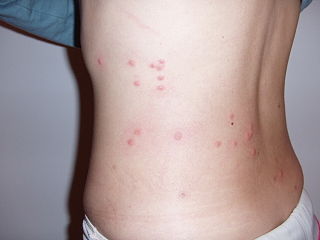 W
WInsect bites and stings occur when an insect is agitated and seeks to defend itself through its natural defense mechanisms, or when an insect seeks to feed off the bitten person. Some insects inject formic acid, which can cause an immediate skin reaction often resulting in redness and swelling in the injured area. Stings from fire ants, bees, wasps and hornets are usually painful, and may stimulate a dangerous allergic reaction called anaphylaxis for at-risk patients, and some wasps can also have a powerful bite along with a sting. Bites from mosquitoes and fleas are more likely to cause itching than pain.
 W
WAnt venom is any of, or a mixture of, irritants and toxins inflicted by ants. Most ants spray or inject a venom, the main constituent of which is formic acid only in the case of subfamily Formicinae.
 W
WA bee sting is the wound and pain caused by the stinger of a female bee puncturing skin. Bee stings differ from insect bites, with the venom of stinging insects having considerable chemical variation. The reaction of a person to a bee sting may vary according to the bee species. While bee stinger venom is slightly acidic and causes only mild pain in most people, allergic reactions may occur in people with allergies to venom components.
 W
WJerome Goddard is an American entomologist currently located at Mississippi State University who is known for research on a number of medically important arthropods, most notably ticks and the common bed bug. His work on the health effects of bed bugs has helped clarify the pathophysiology of cutaneous reactions to their bites., Prior to coming to Mississippi State, Dr. Goddard was an Air Force medical entomologist for 3 years and then State Medical Entomologist for the Mississippi Department of Health for 20 years. After Hurricane Katrina (2005), Dr. Goddard was the health department official responsible for the mosquito and vector control program along the Mississippi Gulf Coast. He is the author of a medical textbook used by physicians which won "Highly Commended" in 2003 in the British Medical Association's Best Medical Book of the Year competition. Over the last two decades Dr. Goddard has served as an educational resource concerning medically important arthropods to a U.S. Congressional Committee, in various newspapers and magazines such as Reader's Digest, and on television programs such as The Learning Channel and the Colbert Report.
 W
WHow a Mosquito Operates is a 1912 silent animated film by American cartoonist Winsor McCay. The six-minute short depicts a giant mosquito tormenting a sleeping man. The film is one of the earliest works of animation, and its technical quality is considered far ahead of its time. It is also known under the titles The Story of a Mosquito and Winsor McCay and his Jersey Skeeters.
 W
WPulicosis is a skin condition caused by several species of fleas, including the cat flea and dog flea. This condition can range from mild irritation to severe irritation. In some cases, 48 to 72 hours after being bitten, a more severe rash-like irritation may begin to spread across the body. Symptoms include swelling of the bitten area, erythema, ulcers of the mouth and throat, restlessness, and soreness of the areolae. In extreme cases, within 1 week after being bitten, the condition may spread through the lymph nodes and begin affecting the central nervous system. Permanent nerve damage can occur.
 W
WThe Schmidt sting pain index is a pain scale rating the relative pain caused by different hymenopteran stings. It is mainly the work of Justin O. Schmidt, an entomologist at the Carl Hayden Bee Research Center in Arizona, United States. Schmidt has published a number of papers on the subject, and claims to have been stung by the majority of stinging Hymenoptera.